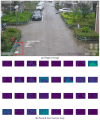EcoDetect-YOLO: A Lightweight, High-Generalization Methodology for Real-Time Detection of Domestic Waste Exposure in Intricate Environmental Landscapes
- PMID: 39066064
- PMCID: PMC11280945
- DOI: 10.3390/s24144666
EcoDetect-YOLO: A Lightweight, High-Generalization Methodology for Real-Time Detection of Domestic Waste Exposure in Intricate Environmental Landscapes
Abstract
In response to the challenges of accurate identification and localization of garbage in intricate urban street environments, this paper proposes EcoDetect-YOLO, a garbage exposure detection algorithm based on the YOLOv5s framework, utilizing an intricate environment waste exposure detection dataset constructed in this study. Initially, a convolutional block attention module (CBAM) is integrated between the second level of the feature pyramid etwork (P2) and the third level of the feature pyramid network (P3) layers to optimize the extraction of relevant garbage features while mitigating background noise. Subsequently, a P2 small-target detection head enhances the model's efficacy in identifying small garbage targets. Lastly, a bidirectional feature pyramid network (BiFPN) is introduced to strengthen the model's capability for deep feature fusion. Experimental results demonstrate EcoDetect-YOLO's adaptability to urban environments and its superior small-target detection capabilities, effectively recognizing nine types of garbage, such as paper and plastic trash. Compared to the baseline YOLOv5s model, EcoDetect-YOLO achieved a 4.7% increase in mAP0.5, reaching 58.1%, with a compact model size of 15.7 MB and an FPS of 39.36. Notably, even in the presence of strong noise, the model maintained a mAP0.5 exceeding 50%, underscoring its robustness. In summary, EcoDetect-YOLO, as proposed in this paper, boasts high precision, efficiency, and compactness, rendering it suitable for deployment on mobile devices for real-time detection and management of urban garbage exposure, thereby advancing urban automation governance and digital economic development.
Keywords: BiFPN; CBAM; P2; domestic waste; intricate environmental landscapes; lightweight.
Conflict of interest statement
The authors declare that the research was conducted in the absence of any commercial or financial relationships that could be construed as a potential conflict of interest.
Figures























Similar articles
-
Improvement of Lightweight Convolutional Neural Network Model Based on YOLO Algorithm and Its Research in Pavement Defect Detection.Sensors (Basel). 2022 May 6;22(9):3537. doi: 10.3390/s22093537. Sensors (Basel). 2022. PMID: 35591227 Free PMC article.
-
BED-YOLO: An Enhanced YOLOv10n-Based Tomato Leaf Disease Detection Algorithm.Sensors (Basel). 2025 May 2;25(9):2882. doi: 10.3390/s25092882. Sensors (Basel). 2025. PMID: 40363318 Free PMC article.
-
LFD-YOLO: a lightweight fall detection network with enhanced feature extraction and fusion.Sci Rep. 2025 Feb 11;15(1):5069. doi: 10.1038/s41598-025-89214-7. Sci Rep. 2025. PMID: 39934394 Free PMC article.
-
LPCF-YOLO: A YOLO-Based Lightweight Algorithm for Pedestrian Anomaly Detection with Parallel Cross-Fusion.Sensors (Basel). 2025 Apr 26;25(9):2752. doi: 10.3390/s25092752. Sensors (Basel). 2025. PMID: 40363191 Free PMC article.
-
Lightweight UAV Landing Model Based on Visual Positioning.Sensors (Basel). 2025 Jan 31;25(3):884. doi: 10.3390/s25030884. Sensors (Basel). 2025. PMID: 39943522 Free PMC article.
Cited by
-
Research on underwater disease target detection method of inland waterway based on deep learning.Sci Rep. 2025 Apr 23;15(1):14072. doi: 10.1038/s41598-025-98570-3. Sci Rep. 2025. PMID: 40269127 Free PMC article.
-
RSW-YOLO: A Vehicle Detection Model for Urban UAV Remote Sensing Images.Sensors (Basel). 2025 Jul 11;25(14):4335. doi: 10.3390/s25144335. Sensors (Basel). 2025. PMID: 40732471 Free PMC article.
-
RSTD-YOLOv7: a steel surface defect detection based on improved YOLOv7.Sci Rep. 2025 Jun 4;15(1):19649. doi: 10.1038/s41598-025-04811-w. Sci Rep. 2025. PMID: 40467733 Free PMC article.
-
Improved faster R-CNN for steel surface defect detection in industrial quality control.Sci Rep. 2025 Aug 17;15(1):30093. doi: 10.1038/s41598-025-12740-x. Sci Rep. 2025. PMID: 40820224 Free PMC article.
-
A Lightweight Strip Steel Surface Defect Detection Network Based on Improved YOLOv8.Sensors (Basel). 2024 Oct 9;24(19):6495. doi: 10.3390/s24196495. Sensors (Basel). 2024. PMID: 39409535 Free PMC article.
References
-
- Kaza S., Yao L., Bhada-Tata P., Van Woerden F. What a Waste 2.0: A Global Snapshot of Solid Waste Management to 2050. World Bank; Washington, DC, USA: 2018. (Urban Development Series).
-
- Torkashvand J., Emamjomeh M.M., Gholami M., Farzadkia M. Analysis of cost–benefit in life-cycle of plastic solid waste: Combining waste flow analysis and life cycle cost as a decision support tool to the selection of optimum scenario. Environ. Dev. Sustain. 2021;23:13242–13260. doi: 10.1007/s10668-020-01208-9. - DOI
-
- Jonidi Jafari A., Latifi P., Kazemi Z., Kazemi Z., Morovati M., Farzadkia M., Torkashvand J. Development a new index for littered waste assessment in different environments: A study on coastal and urban areas of northern Iran (Caspian Sea) Mar. Pollut. Bull. 2021;171:112684. doi: 10.1016/j.marpolbul.2021.112684. - DOI - PubMed
Grants and funding
LinkOut - more resources
Full Text Sources
Miscellaneous

